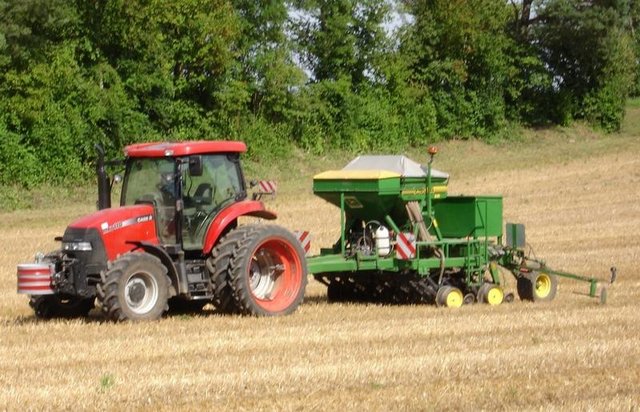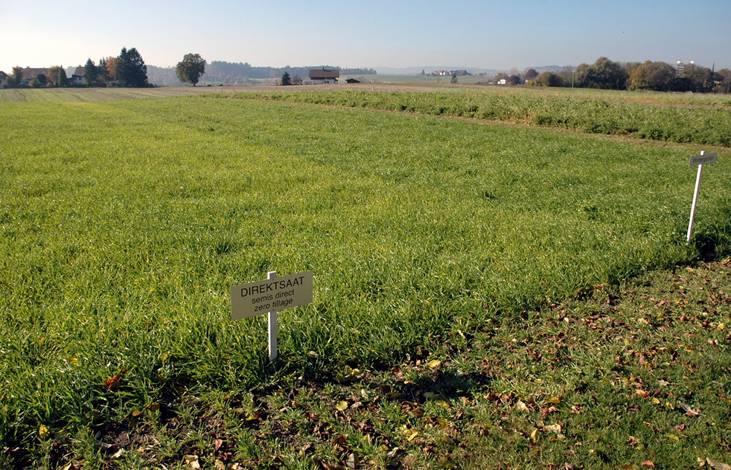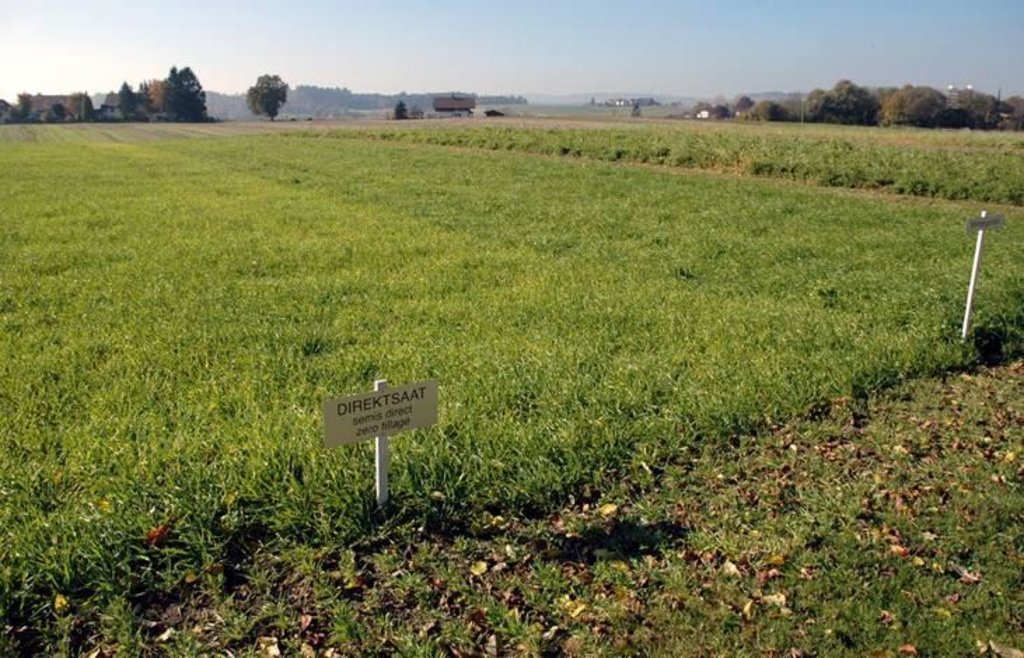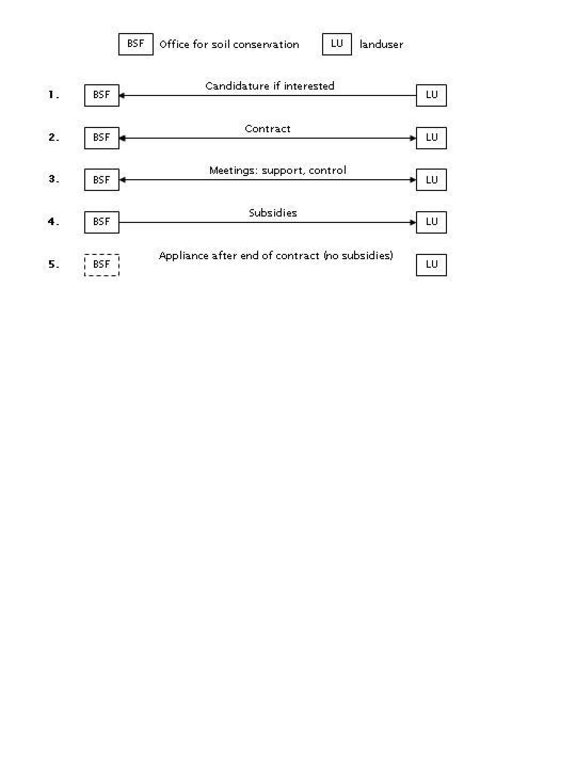Subsidies for conservation agriculture [瑞士]
- 创建:
- 更新:
- 编制者: Unknown User
- 编辑者: –
- 审查者: David Streiff
Umstellungsverträge
approaches_2632 - 瑞士
查看章节
全部展开 全部收起1. 一般信息
1.2 参与方法评估和文件编制的资源人员和机构的联系方式
关键资源人员
SLM专业人员:
Wyler Roman
瑞士
SLM专业人员:
Hofer Peter
+41 (0)31 970 53 37
Peter.hofer@vol.be.ch
Amt für Landwirtschaft und Natur des Kantons Bern LANAT
Rütti, 3052 Zollikofen
瑞士
有助于对方法进行记录/评估的机构名称(如相关)
Amt für Landwirtschaft und Natur des Kantons Bern (LANAT) - 瑞士1.3 关于使用通过WOCAT记录的数据的条件
编制者和关键资源人员接受有关使用通过WOCAT记录数据的条件。:
是
1.4 SLM技术问卷的参考

Direct seeding [瑞士]
A cropping system which allows to plant the seeds directly into the soil without ploughing. The soil is covered with plant remainders.
- 编制者: Unknown User
2. SLM方法的描述
2.1 该方法的简要说明
Land users commit to apply conservation agriculture on parts of their land for a period of 5 years. In return they get subsidies during this period.
2.2 该方法的详细说明
该方法的详细说明:
Aims / objectives: The Swiss environment protection law defines that soil fertility must be conserved on a long term basis. The cantons have to execute this national law. The way this is done differs from canton to canton. In this study the strategy of the canton of Berne is documented. It has three major goals: The prevention of soil erosion, the reduction of nitrate wash out and the prevention of soil compaction.
Methods: To reach these goals, farmers who accept to use conservation technologies can get additional subsidies for a period of 5 years. Furthermore they are supported by advisors. In this way land users are encouraged to change to soil conservation technologies, financial risk during the establishment phase is reduced due to the subsidies. The approach consist basically of a contract between land users and the office for soil conservation, in which land users commit to apply only soil conservation technologies on parts or on all their land during a period of 5 years. During that time direct seeding must be applied at least 2 times for main crops and for half of the catch crops. For the remaining crops ploughing is not allowed either. Technologies which reduce the reworking of the soil such as maize strip tillage ('Streifenfrässaat') or mulching need to be applied. In return land users get subsidies (during 5 years) which depend on the crop and the technology used. The highest subsidies are granted if direct seeding is used. The office for soil conservation is running a demonstration study comparing direct seeding to conventional agriculture. This helps land users to estimate the effects the new technology would have when applied in practice. If a specific farm receives the subsidies depends on whether in the running year there is still financial resources for the program. Resources have been limited by the government. Additionally it depends on where the farm is located. Farms that located in regions of major nitrate contamination, enhanced risk of eronsion or soil compaction or in regions with drinking water sources or polluted surface water are incorporated first. Land users can have their whole farm or single fields under contract. However a specific field can not be under contract for more than one period (5 years). As soon as a farmer gets a contract, details about which crop to plant where and when, with which technology are discussed by the farmer and an advisor.
Other important information: The goal is to find the best solution for every land user. Meetings of that kind take place on a regular basis. Besides supporting the farmer, advisors also check if conservation agriculture technologies are really being applied. After the 5 years under contract, it is the land users choice whether they want to continue using conservation technologies or not. Monitoring of the office for soil conservation shows that 85% keep on using conservation technologies. Its seems that the approach has a long term influence and subsidies are needed in the beginning only.
2.3 该方法的照片
2.5 采用该方法的国家/地区/地点
国家:
瑞士
区域/州/省:
Canton of Berne
Map
×2.6 该方法的开始和终止日期
注明开始年份:
1996
注释:
It is possible to get subsidies in the whole canton of Berne. Cropland area in the canton is 539 km2, 2517 ha were under contract in the year 2006.
2.7 方法的类型
- 基于项目/方案
2.8 该方法的主要目的/目标
The Approach focused on SLM only
Spreading of conservation agriculture in areas with an enhanced risk for soil erosion and or washing out of nutritients. Good quality support so that farmers will not have lower crop yield due to the technology and therefore continue using conservation agriculture after 5 years without external support.
The SLM Approach addressed the following problems: Water erosion under intense rainfall. Washing out of Nitrate to the ground water. Soil compaction.
2.9 推动或妨碍实施本办法所适用的技术的条件
社会/文化/宗教规范和价值观
- 阻碍
Ploughing is an important part of the tradition of agriculture. People are very critical towards no-tillage technologies, since they don't fit the common understanding of agriculture.
Treatment through the SLM Approach: The people working in the project are farmers themselves. They can give on their practical experience. Furthermore a demonstration study can be visited
财务资源和服务的可用性/可得性
- 阻碍
Most farmers have achinery for conventional agriculture. To change to conservation agriculture major investments need to be done or contractors need to be tasked. Furthermore crop yield can be lowered in the beginning.
Treatment through the SLM Approach: When changing to conservation agriculture farmers are supported financially for a period of 5 years.With this money the risk in case of crop failure ond the costs for a contractor are lowered.farmers can test a new techniquewithout major expenses or risks
法律框架(土地使用权、土地和水使用权)
- 阻碍
If the owner of the farm changes, the new owner often returns to conventional agriculture.
Treatment through the SLM Approach: No solution inside the project
The existing land ownership, land use rights / water rights hindered a little the approach implementation In Switzerland the number of farms is decreasing. New owners of land sometimes change back to conventional agriculture. It is possible however, that the new owner introduces conservation technologies.
其他
- 阻碍
In Switzerland there are subsidies to support farmers in hilly terrain. This encourages farmers plant crops on steeper slopes and therefore enhances the risk of erosion. This is not a constraint for the technology however.
Treatment through the SLM Approach: Conservation agriculture helps to reduce erosion. However the project cannot change the fact, that these subsidies enhance the risk of erosion.
3. 相关利益相关者的参与和角色
3.1 该方法涉及的利益相关者及其职责
- 当地土地使用者/当地社区
Contracts are signed by the office for soil conservation and the head of the farm, who in general is male. The decision about which technology is applied is usually taken at the household level including both women and men.
- SLM专家/农业顾问
- 国家政府(规划者、决策者)
The national government tasked the cantons with soil conservation. Therefore approaches differ from canton to canton.
3.2 当地土地使用者/当地社区参与该方法的不同阶段
| 当地土地使用者/当地社区的参与 | 指定参与人员并描述活动 | |
|---|---|---|
| 启动/动机 | 无 | The project was introduced through the office for soil conservation |
| 计划 | 互动 | Landusers who wish to get subsidies have contact the office for soil conservation. It is the land users decision on which of their fields they want apply the technology. |
| 实施 | 外部支持 | Land user get subsidies for a period of 5 years, during which they have to apply soil conservation technologies. To actually use the technology they task a contractor or do the work on their own. |
| 监测/评估 | 互动 | As there are discussions with the advisor on a regular basis, the implementation of the technology is monitored both by the farmer and the advisor. |
| Research | 无 | There is a demonstration study where direct seeding and conventional agriculture is compared. |
3.3 流程图(如可用)
具体说明:
Interactions between the office for soil conservation and land users during the progression of the project.
作者:
Roman Wyler
3.4 有关SLM技术选择的决策
具体说明谁有权决定选择要实施的技术:
- 主要是SLM专家,咨询土地使用者之后
解释:
The decisions were taken by the office for soil conservation. Since these people are working as farmers, too, land users perspective could be included.
Decisions on the method of implementing the SLM Technology were made by mainly by land users supported by SLM specialists. To get the subsidies criteria from the contract need to be accepted. Besides this, land users can decide on their own how land is cultivated.
4. 技术支持、能力建设和知识管理
4.1 能力建设/培训
是否为土地使用者/其他利益相关者提供培训?:
否
4.2 咨询服务
土地使用者有权使用咨询服务吗?:
是
指明是否提供了咨询服务:
- 在土地使用者的土地上
说明/注释:
nnual meetings between land user and advisor; Key elements: Technical support, Planning of crop rotation and technologies applied, Monitoring
Advisory service is quite adequate to ensure the continuation of land conservation activities; Following a study of the office for soil conservation most land users continue to use conservation technologies after the end of the contract.
4.3 机构强化(组织发展)
是否通过这种方法建立或加强了机构?:
- 是,少许
具体说明机构的强化或建立程度:
- 本地
提供进一步细节:
The office for soil conservation was involved in Swiss no-till, which is a platform to exchange knowledge.
4.4 监测和评估
监测和评估是该方法的一部分吗?:
是
注释:
bio-physical aspects were regular monitored by 0 through observations; indicators: advisory meetings
technical aspects were regular monitored by 0 through observations; indicators: advisory meetings
economic / production aspects were None monitored by 0 through measurements; indicators: farmer himself
area treated aspects were None monitored by government through measurements; indicators: only the area under contract is known
no. of land users involved aspects were None monitored by 0 through None; indicators: only the number of land users under contract is known
survey aspects were None monitored by land users through None; indicators: afther the first two years there was an evalution of the project. Farmers were asked for their opini
4.5 研究
研究是该方法的一部分吗?
是
明确话题:
- 技术
提供进一步的细节,并指出是谁做的研究:
Research is not part of the actual project. However the advisors are involved in research projects through other activities. Therefore new knowledge is usually incorporated in the advisory meetings.
Research was carried out both on station and on-farm
5. 融资和外部物质支持
5.1 该方法中SLM组成部分的年度预算
如果不知道准确的年度预算,请给出一个范围:
- 100,000-1,000,000
注释(例如主要的资助来源/主要捐助者):
Approach costs were met by the following donors: government (Kanton Bern): 100.0%
5.2 为土地使用者提供财政/物质支援
土地使用者是否获得实施该技术的财政/物质支持?:
是
如果是,请具体说明支持的类型、条件和提供者:
Canton of Berne
5.3 对特定投入的补贴(包括劳动力)
- 农业
| 具体说明哪些投入得到了补贴 | 程度如何 | 对补贴做出具体说明 |
|---|---|---|
| 种子 | 部分融资 | |
| 化肥 | 部分融资 | |
注释:
There are subsidies per field under contract for a period of 5 years. During that time direct seeding must be applied at least 2 times for main crops and for half of the catch crops. For the remaining crops ploughing is not allowed either.
5.4 信用
是否根据SLM活动的方法给予信用值?:
否
6. 影响分析和结论性陈述
6.1 方法的影响
该方法是否帮助土地使用者实施和维护SLM技术?:
- 否
- 是,很少
- 是,中等
- 是,支持力度很大
the advisory meetings help land users to better understand soil processes.
该方法是否有助于社会和经济弱势群体?:
- 否
- 是,很少
- 是,中等
- 是,支持力度很大
Did other land users / projects adopt the Approach?
- 否
- 是,很少
- 是,中等
- 是,支持力度很大
Other cantons in Switzerland have started to subsidise conservation agriculture too.
Did the Approach lead to improved livelihoods / human well-being?
- 否
- 是,很少
- 是,中等
- 是,支持力度很大
income is slightly enhanced in most cases.
Did the Approach help to alleviate poverty?
- 否
- 是,很少
- 是,中等
- 是,支持力度很大
6.2 土地使用者实施SLM的主要动机
- 增加利润(能力),提高成本效益比
- 支付/补贴
- 环境意识
prevention of erosion
6.3 方法活动的可持续性
土地使用者能否维持通过该方法实施的措施(无外部支持的情况下)?:
- 是
若是,请说明如何维持:
on a long term perspective conservation agriculture is rather cheaper. Only in the beginning it costs more.
6.4 该方法的长处/优点
| 土地使用者眼中的长处/优势/机会 |
|---|
| Not land user, but advisor of the project! |
| The structure of the project enables individual solutions. Still there are incentives for conservation agriculture. (How to sustain/ enhance this strength: Working together with the land users, searching for the best individual solution.) |
| After the end of the contract, there are no costs anymore. (How to sustain/ enhance this strength: armers should be supported as good as possible, so that they are familiar with the technology and continue to apply it after the end of the contract.) |
| Advisors involved in the project all have an agricultural background, they are therefore familiar with the problems of farmers. (How to sustain/ enhance this strength: Working together with the farmers and trying adjust the program to their needs.) |
6.5 该方法的弱点/缺点以及克服它们的方法
| 土地使用者认为的弱点/缺点/风险 | 如何克服它们? |
|---|---|
| Compared to the total number of farms the number of participants is rather small. | conditions for participation could be reduced in order to reach more people. This would however increase the costs. |
| 编制者或其他关键资源人员认为的弱点/缺点/风险 | 如何克服它们? |
|---|---|
| Subsidies are expensive for the state. Since resources are limited there is already a waiting list for the farmers. | soil consvervation should get a higher importance in politics. This is not the case because most people don't even know that soil degradation is a problem. |
| f there is no possibility to rent the machines in the region, costs are very high, even if there are subsidies. | here it could be a possiblity to support contractors to buy the machines needed, so that land users could apply the technology at lower costs. |
7. 参考和链接
7.1 方法/信息来源
- 实地考察、实地调查
- 与SLM专业人员/专家的访谈
7.2 参考可用出版物
标题、作者、年份、ISBN:
Amt für Landwirtschaft und Natur des Kantons Bern LANAT, Rütti, 3052 Zollikofen. Kanton Bern fördert Ressourcen schonenden Ackerbau.AGRARForschung 14 (3): 128-133, 2007.
可以从哪里获得?成本如何?
http://www.vol.be.ch/site/lanat-3155-mbressourcen.pdf
链接和模块
全部展开 全部收起链接

Direct seeding [瑞士]
A cropping system which allows to plant the seeds directly into the soil without ploughing. The soil is covered with plant remainders.
- 编制者: Unknown User
模块
无模块






